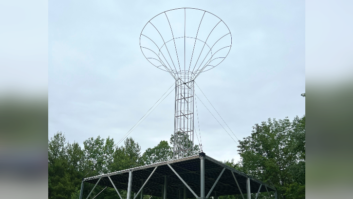Alan Shea, an engineer with the technical department of HCJB, discovered something that might be useful for helping to cut down on copper losses, at least for ground rods, close-in radials and ground straps.
ERICO International Corp., makers of Cadweld and other grounding and protection equipment, has a product called GEM25A.

Fig. 1: ERICO Ground Enhancement Material is a conductive material that solves grounding problems and makes an interesting deterrent for copper thieves. This example shows a trench installation.
GEM stands for Ground Enhancement Material. GEM25A is a carbon-loaded Portland cement with an effective typical resistivity of 12–18 ohms. Pouring this around ground wires would seriously slow down copper thieves, encouraging them to go somewhere else.
It would also improve the effectiveness of the ground wires. Alan’s not sure if this would affect antenna impedances; maybe one of the consulting engineers who read this column can weigh in with an opinion.
ERICO has a downloadable calculator for estimating the amount of GEM required for a particular application. Find it at www.erico.com/products/GEM.asp.
Senior Technical Support Specialist George Kub states that the conductive materials added to GEM for its ground-enhancing mission reduces its overall strength, so GEM is not suited for structural intent, such as in a footing or foundation, or freestanding applications such as supporting a pier or pylon. Conductor encasement (in a trench) in GEM would help to lower system resistance and likely make life more difficult for copper thieves.
Send application questions to George Kub at [email protected], or call ERICO Customer Service at (800) 677-9089. Thanks, Alan, for sharing this information with readers of Workbench.
I’m a long-time user of ERICO products. If you haven’t used them for welding strap and cable to ground rods, you’re missing out on a really neat technology. The process is quick and secure. Visit the company’s website to find out more, www.erico.com. Under the library tab, search for cadweld video.
* * *
Jon Hosford is director of engineering for Montpelier Broadcasting in Vermont. Robert Combs’ story about bullet damage at the transmitter site (Workbench, June 1) made him think of one of his old facilities.
The original WNCS(FM) site was controversial when built in the early 1980s. Given the controversy, the original station owner was worried someone would try to shoot the building.
So he experimented. He took a 30-06 rifle and shot at a 2-by-4, in the thick direction. It went through. He worked his way up to a 2-by-10 board, which finally stopped the bullet.
Experiment completed, he build the building entirely of 2-by-10 boards laying flat! The door was steel.
Yes, this construction made penetrating the walls to run lines tougher; but Jon reports there was never a problem with vandalism.
* * *
A few days ago, our Radio World colleague Buc Fitch realized he was running short of small 6-32 nuts. Those are the ones you use when a nut needs to sit up tight against a component or chassis wall.

Fig. 2: Not all nuts are created equal.
A more usual requirement is when you need to screw down a solder lug; the bigger nuts are so large that they sometimes cover the first solder hole in the lug.
Buc had trouble finding a supplier of the smaller cross-section nuts, at least in quantities in the hundreds. (He did find a vendor who could provide them, with a minimum order of 40,000 pieces!)
His old friend Xen Scott mentioned that he’d just bought some 6-32 hardware from Lowes, and that the nuts in the box were notably small. At Xen’s suggestion, Buc went over to Lowes and, yes, the nuts in the bubble pack that came with the 6-32 bolts were ultra-small, so tiny that they needed a 7/32-inch socket driver instead of the usual 1/4-inch driver.
Lowes has a strange pricing structure for these parts. The 1/2-inch to 1-1/4-inch bolt length in 100 quantity are all the same price, just under $5 a pack. The 1-1/2-inch lengths come 75 in a pack for the same price.
Since his goal was to acquire the nuts, Buc chose the 1-1/4 inch, a length he didn’t have in the parts drawers. The Lowes part number is H# 35277.
He now has three sizes of nuts for 6-32 screws: the usual 0.303 to 0.313 inch “large” nut; the typical 1/4-inch nut; and these new, useful “ultra small” nuts from Lowes.
With parts being increasingly sourced from Asia, Buc finds it getting harder to find good-quality parts he needs. He raises a good point with the quality issue. Use caution when selecting bolts and nuts to mount heavy items like coaxial transfer switches. The quality of steel in hardware sold at many stores is suspect. In a typical failure, the head of the screw or bolt breaks off as the device is tightened — disastrous when hanging a transfer switch or filter.
Contribute to Workbench. You’ll help your fellow engineers and qualify for SBE recertification credit. Send Workbench tips to [email protected]. Fax to (603) 472-4944.
John Bisset has spent 43 years in the broadcasting industry, and is still learning. He works for Tieline Technology, is SBE Certified and is a past recipient of the SBE’s Educator of the Year Award.







